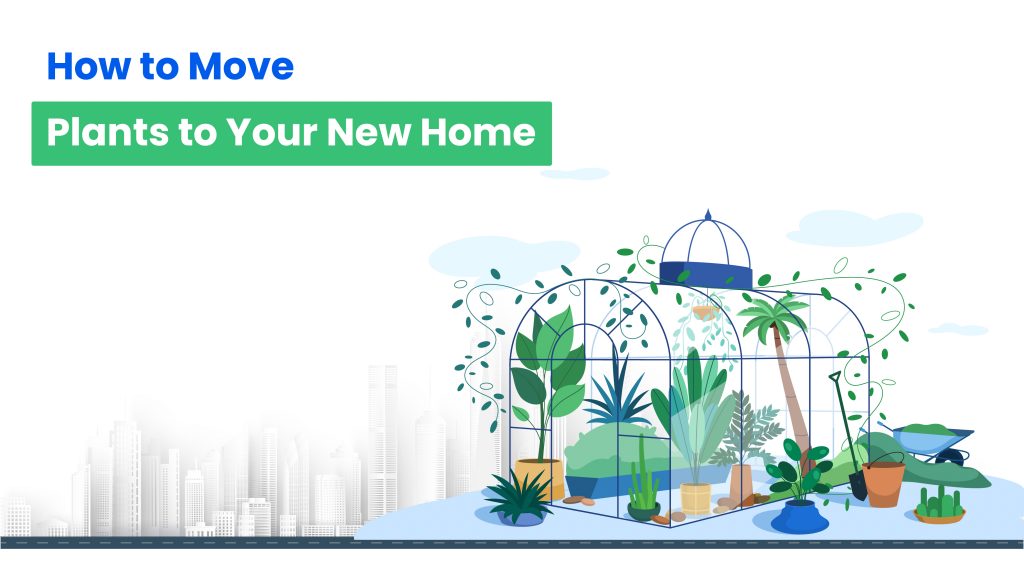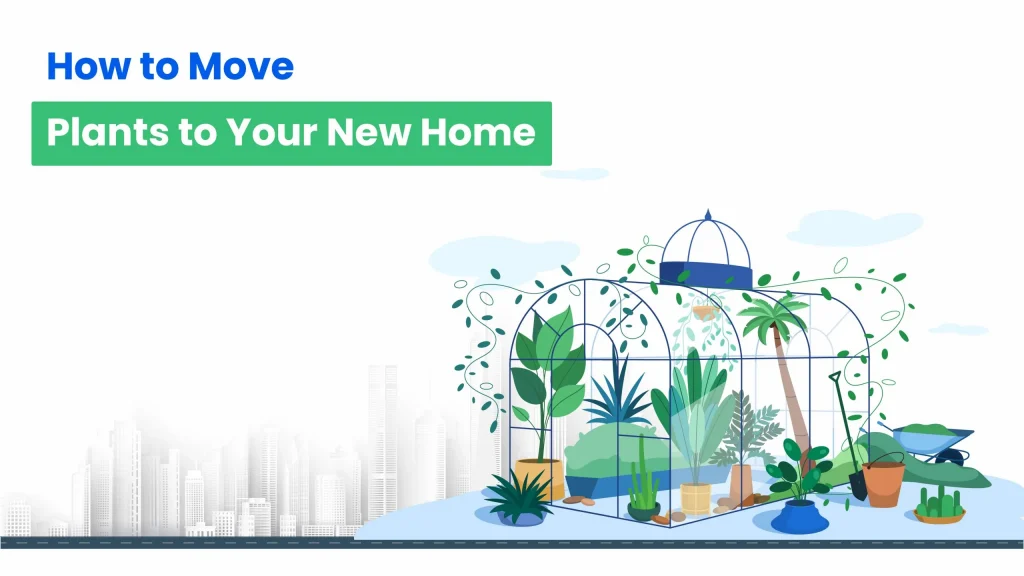First of all, pat yourself. You have done a great job in nurturing the plants. Now you are reading this blog to ensure the safe moving of your plants; We will not disappoint you.
Check out the blog to prepare your plants for moving, ship them safely and allow them to blossom again. Moving with plants is similar to moving with pets. Plants need equal care and protection while moving them. This care can be ensured in three phases.

Prepare Your Plants
The first and foremost step is to prepare your plants to move. It can be coined as a pre-relocation segment.
1. Make a list
Make a list of the plants you have. Don’t worry. You can leave their scientific names out of the way. Just list out their common names to look up on the net or in a plant guide.
Why make this list?
This list will guide you in moving with plants. It will give you an idea of the types of plants(shrubs, creepers, flower pots)and the quantity of packing supplies to buy.
2. Know your plants
Check out each plant to know about precautions. It may include reasons for wilting, shedding leaves or some instructions to follow while shipping the plants.
If you have been growing plants for a long time, you would know their needs and precautions. It is the best time to recollect them and jot them down.
3. Classify the plants
When you are ready with the list, the next step is classification. It does not have to be a scientific classification of species!
Some plants are sensitive and wilt quickly during changes in their surroundings. These need to be grouped separately.
Some plants, like cacti, can survive harsh conditions. Flowering plants need special care.
Group out the plants to provide customized packing and care.
4. Gather necessary supplies
Once you know the number and types of plants, it’s time to gather the necessary packing supplies for them.
Packing Supplies That Can Help You Move With The Plants
1. Plant packing carton boxes
Unlike regular carton boxes, these are customized for plants. They come in short, medium and large sizes. The difference between carton boxes and plant packing boxes is that they have an opening at the top to let the stem stand out. The box can be closed to protect the roots and the pot.
2. Corrugated carton boxes
These carton boxes provide an additional layer of support to plants. Delicate plants and flower pots can be moved protectively in corrugated carton boxes.
3. Water sprinkler
It is a must-have tool for any plant lover. Remember to carry a water sprinkler in your plant packing tool kit.
It will be easy with a water sprinkler to refresh the plants during the move. If you are moving the plants through helpers or a moving company, offer a water sprinkler to hydrate your plants during the journey.
4. Wooden carrier
Wood carrier helps you transport live plants. It is a wooden flask and a perfect choice for delicate seedlings. Saplings with bare roots can be placed and moved through these easily.
5. Plastic cover
Plastic covers are needed to cover the stem part of the plant. These covers protect the plant from heat, dust, and moisture. They help to stabilize the temperature within coverage, which gives more time to move the plants.
6. Terracotta pots
These are inexpensive pots made of terracotta. These pots absorb excess moisture from plants and keep them safe from water logging and pest attacks. If you are moving with the plants during the rainy season, then shift your plants to terracotta pots.
7. Self-watering pots
These pots come in two layers. The outer glass cylinder layer holds the water. The inner terracotta pots absorb water from the outer pot and seep it inside when necessary.
Go for self-watering pots if a third party or any moving company is moving the plants to your new home.
a) Quench their thirst
Water and sunlight are the twin essentials of plants. Water the plants a minimum of three days before packing.
Fill in mud in deficit areas of the pot to increase its water retention. Keep enough supplies of fertilizers or other nutrients regularly added to the plants. Add them before you pack the plants. Neem oil is a natural pesticide for plants. Grease the leaves and stems of your plants with neem oil to protect them from pests and fungal attacks.
b) Prune overgrown plants
Prune the leaves of overgrown plants. It assists in two ways: Pruning the leaves will activate them to regrow. The reduced size will be easier to pack and transport. When you shift into your new home, your plants will bloom again.
How to Pack and Ship the Plants??
1. Large sized plants
It is challenging to fit large-sized plants in a box. A better way is to prune the leaves and cover the upper part in plastic wrap. Then these can be carried directly to the truck.
2. Small sized plants
Medium to small-sized plants can be packed in two ways:
The first one is to pack the pots in durable carton boxes. These boxes come in varied sizes and shapes to accommodate plants. This method is useful for plastic and fibre pots.
The second one is to place the plant(with roots intact) in a plastic cover with mud. This method is suitable for earthen pots. As earthen pots are heavy to carry and prone to damage, it is advisable to carry them separately.
Tips to Protect and Restore the Plants
1. Talk to the movers
Ask your moving company if they provide plant relocation services. If yes, you can share the details of your plants with the movers. When the movers arrive to take the plants, convey the instructions(if any ) to them.
2. Move the plants yourself
Some moving companies do not offer plant relocation services. Well, in that case, the onus falls on you.
If you own a vast nursery of plants, arrange a vehicle with ventilation facilities.
If you are shipping the plants long distances, ask truck drivers or caretakers to let in air and water at reasonable intervals.
If your plant collection is small and selective, carry the plants with you during the relocation. If you move the plants by yourself, you can regularly water them and provide better care.
3. Restoration
This is the last step of moving with plants. Once the plants reach your new home, free them from the box. Provide ample sunlight and water to help them recover.
Even after all the precautions, some plants may show discoloration (due to sunlight deficiency) or even wilting. You do not have to panic.
Even after moving the plants, they need time to adapt to new surroundings and weather conditions.
If you are moving to icy areas, move with plants that can thrive in extreme cold and low sunlight.
Also, if you are moving to places with high temperatures, try plants that survive well in sunshine and humidity.
There are multiple reasons for growing plants at home. They provide basic groceries to the home, purify the air, enhance the aesthetics and much more!! But an unconscious reason to grow plants is that they are dear to us, just like pets!
With such importance, moving the plants to your new home can be a tricky task. It would help if you plan well (What plants to take and how??) and execute it accordingly. So go ahead, Prepare your plants for the new journey and get set going!!
Have a happy move with the plants!



